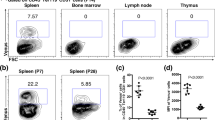Abstract
The capacity of secondary lymphoid organs to provide suitable tissue environment for mounting immune responses is dependent on their compartmentalized stromal constituents, including distinct fibroblasts. In addition to various members of the tumor necrosis factor/lymphotoxin β family as important morphogenic regulators of peripheral lymphoid tissue development, the formation of stromal elements of spleen is also influenced by the Nkx2.3 homeodomain transcription factor in a tissue-specific fashion. Here we extend our previous work on the role of Nkx2.3-mediated regulation in the development of spleen architecture by analyzing the structure of reticular fibroblastic meshwork of spleen in inbred Nkx2.3-deficient mice. Using immunohistochemistry and dual-label immunofluorescence we found both distributional abnormalities, manifested as poor reticular compartmentalization of T-zone and circumferential reticulum, and developmental blockade, resulting in the absence of a complementary fibroblast subpopulation of white pulp. The disregulated distribution of fibroblasts was accompanied with an increased binding of immunohistochemically detectable complement factor C4 by T-cell zone-associated reticular fibroblasts, distinct from follicular dendritic cells with inherently high-level expression of bound C4. These data indicate that the impact of Nkx2.3 gene deficiency on fibroblast ontogeny within the spleen extends beyond its distributional effects, and that the formation of various white pulp fibroblast subsets is differentially affected by the presence of Nkx2.3 activity, possibly also influencing their role in various immune functions linked with complement activation and deposition.
Similar content being viewed by others
Abbreviations
- BSA:
-
bovine serum albumin
- CFR:
-
circumferential reticulum
- FDC:
-
follicular dendritic cell
- mAb:
-
monoclonal antibody
- MAdCAM-1:
-
mucosal addressin cell adhesion molecule-1
- PALS:
-
periarteriolar lymphoid sheath
- PBS:
-
phosphatebuffered saline
- PE:
-
phycoerythrin
- TNF/LT:
-
tumor necrosis factor/lymphotoxin
References
Fu YX, Chaplin DD: Development and maturation of secondary lymphoid tissues. Annu Rev Immunol 17: 399–433, 1999.
Mebius RE: Organogenesis of lymphoid tissues. Nat Rev Immunol 3: 292–303, 2003.
Weih F, Caamano J: Regulation of secondary lymphoid organ development by the nuclear factor-kappaB signal transduction pathway. Immunol Rev 195: 91–105, 2003.
Gommerman JL, Browning JL: Lymphotoxin/light, lymphoid microenvironments and autoimmune disease. Nat Rev Immunol 3: 642–655, 2003.
Brendolan A, Ferretti E, Saisi V, Moses K, Quaggin S, Blasi F, Cleary ML, Selleri L: A Pbx 1-dependent genetic and transcriptional network regulates spleen ontogeny. Development 132: 3113–3126, 2005.
Browning JL, French LE: Visualization of lymphotoxin-beta and lymphotoxin-beta receptor expression in mouse embryos. J Immunol 168: 5079–5087, 2002.
Tumanov AV, Grivennikov SI, Shakhov AN, Rybtsov SA, Koroleva EP, Takeda J, Nedospasov SA, Kuprash DV: Dissecting the role of lymphotoxin in lymphoid organs by conditional targeting. Immunol Rev 195: 106–116, 2003.
Pabst O, Forster R, Lipp M, Engel H, Arnold HH: NKX2.3 is required for MAdCAM-1 expression and homing of lymphocytes in spleen and mucosa-associated lymphoid tissue. EMBO J 19: 2015–23, 2000.
Wang CC, Biben C, Robb L, Nassir F, Barnett L, Davidson NO, Koentgen F, Tarlinton D, Harvey RP: Homeodomain factor Nkx2-3 controls regional expression of leukocyte homing coreceptor MAdCAM-1 in specialized endothelial cells of the viscera. Dev Biol 224: 152–167, 2000.
Tarlinton D, Light A, Metcalf D, Harvey RP, Robb L: Architectural defects in the spleens of Nkx2-3-deficient mice are intrinsic and associated with defects in both B cell maturation and T cell-dependent immune responses. J Immunol 170: 4002–4010, 2003.
Balogh P, Balázs M, Czömpöly T, Weih DS, Arnold HH, Weih F: Distinct roles of lymphotoxin-beta signaling and the homeodomain transcription factor Nkx2.3 in the ontogeny of endothelial compartments in spleen. Cell Tissue Res 328: 473–486, 2007.
Balogh P, Horváth G, Szakal AK: Immunoarchitecture of distinct reticular fibroblastic domains in the white pulp of mouse spleen. J Histochem Cytochem 52: 1287–1298, 2004.
Taylor PR, Pickering MC, Kosco-Vilbois MH, Walport MJ, Botto M, Gordon S, Martinez-Pomares L: The follicular dendritic cell restricted epitope, FDC-M2, is complement C4; localization of immune complexes in mouse tissues. Eur J Immunol 32: 1888–1896, 2002.
Van Vliet E, Melis M, Foidart JM, Van Ewijk W Reticular fibroblasts in peripheral lymphoid organs identified by a monoclonal antibody. J Histochem Cytochem 34: 883–890, 1986.
Katakai T, Hara T, Sugai M, Gonda H, Shimizu A: Lymph node fibroblastic reticular cells construct the stromal reticulum via contact with lymphocytes. J Exp Med 200: 783–795, 2004.
Balogh P, Aydar Y, Tew JG, Szakal AK: Ontogeny of the follicular dendritic cell phenotype and function in the postnatal murine spleen. Cell Immunol 214: 45–53, 2001.
Yoshida K, Tamahashi N, Matsuura N, Takahashi T, Tachibana T: Antigenic heterogeneity of the reticular meshwork in the white pulp of mouse spleen. Cell Tissue Res 266: 223–229. 1991.
Skibinski G, Skibinska A, Stewart GD, James K: Enhancement of terminal B lymphocyte differentiation in vitro by fibroblast-like stromal cells from human spleen. Eur J Immunol 28: 3940–3948, 1998.
Nolle MA, Bellen JA, Schadee-Eestermans I, Jansen W, Unger WW, van Rooijen N, Kraal G, Mebius RE: A conduit system distributes chemokines and small blood-borne molecules through the splenic white pulp. J Exp Med 198: 505–512, 2003.
Lotscher M, Recher M, Hunziker L, Klein MA: Immunologically induced, complement-dependent up-regulation of the prion protein in the mouse spleen: follicular dendritic cells versus capsule and trabeculae. J Immunol 170: 6040–6047, 2003.
Wang SL, Kutche M, DiSciullo G, Schachner M, Bogen SA: Selective malformation of the splenic white pulp border in L1-deficient mice. J Immunol 165: 2465–2473, 2000.
Kraal G, Schornagel K, Streeter PR, Holzmann B, Butcher EC: Expression of the mucosal vascular addressin, MAd-CAM-1, on sinus-lining cells in the spleen. Am J Pathol 147: 763–771, 1995.
Author information
Authors and Affiliations
Corresponding author
Rights and permissions
About this article
Cite this article
Bovári, J., Czömpöly, T., Olasz, K. et al. Complex organizational defects of fibroblast architecture in the mouse spleen with Nkx2.3 homeodomain deficiency. Pathol. Oncol. Res. 13, 227–235 (2007). https://doi.org/10.1007/BF02893503
Received:
Accepted:
Issue Date:
DOI: https://doi.org/10.1007/BF02893503




